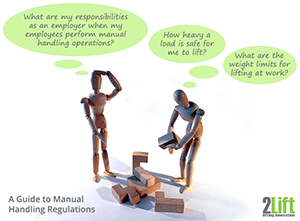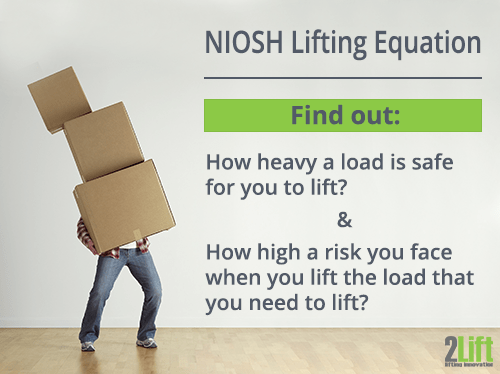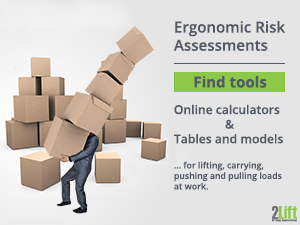Ireland
Manual Handling Regulations and Ergonomic Risk Assessment Tools in Ireland
If you’re an employer living in Ireland and are on the lookout for information on manual handling regulations and ergonomic risk assessment tools to protect your workers from MSDs, we hope that with this page we will help you well on your way.
On this page, you will find:
- An introduction to the main Irish authority dealing with occupational health and safety, including the field of manual handling.
- A quick walk-through of the risk factors in manual handling.
- The legislative essence of employer responsibilities in relation to the manual handling of loads
- Ergonomic risk assessment tools for lifting, lowering, carrying, pushing and pulling.
The Authority Responsible for Manual Handling in Ireland
In Ireland there seems to be only one main authority in the field of occupational safety and health, HSA (Health and Safety Authority).
HSA (also just referred to as the ‘Authority’) is the body responsible for providing the means to ensure that workers are protected from work related health risks such as e.g. accidents and injuries. Thus their work is largely preventive in nature.
HSA’s active role is both advisory and law enforcing. Thus HSA both creates information material and guidelines on how to improve working conditions across all working sectors, and they possess a role as law enforcement body monitoring companies and issuing warnings or fines, if safety measures aren’t living up to legislation (which also includes the manual handling regulations).
In Ireland the legislative framework for occupational safety and health is to be found in the Safety, Health and Welfare at Work Act 2005.
This Act delineates the responsibilities of the employers and employees, as well as that of HSA itself.
The Act takes a preventive approach to occupational accidents and ill-health. In practical terms this means that performing of risk assessments to identify hazards (also those of an ergonomic nature) is mandatory for employers. You can find a guide to the Act here.
In order to help employers comply with the law (here, manual handling regulations), HSA has created a lot of fairly easy-to-read material on manual handling and ergonomics.
In their Guide to the Safety, Health and Welfare at Work HSA, among other things, describe the employer’s manual handling responsibilities as well as providing ergonomic guidelines for lifting and risk assessment tools for manual handling operations. This document, however, is not all that quick a thing to scan through, so in the following we have extracted some of the most relevant points from it.
Being well in line with the EU Directive 90/269/EEC (also unofficially known as the ‘Manual Handling Directive’), the document basically says that:
It is the employer’s responsibility to ensure that no workers are exposed to health risks from the manual handling of loads. If there is a risk, then employer must find means to avoid the activity or reduce the need for manual handling.
Furthermore, all manual handling activities must be risk assessed and if the operation is found to be risky, then either organizational changes or mechanical aids must be introduced to avoid or reduce the risk of MSDs.
Workers have the right to receive information about and training specific to the manual handling activity.
The Risk Factors in Manual Handling
In The Safety, Health and Welfare at Work (General Application) Regulations in Schedule 3, Regulation 69, the typical risk factors inherent in manual handling that employers need to be aware of are:
- The characteristics of the load (too heavy, to large, too awkward to grasp, contains unstable contents etc.)
- The physical efforts required to manage the load (too strenuous, unfortunate posture e.g. twisting the trunk etc.)
- The characteristics of the working environment (too little space to maneuver, problematic flooring, too high or too low temperature etc.)
- The requirements of the activity (such as too little rest, not self-paced etc.)
- Individual risk factors (not physically well-suited for the task, have no knowledge/training etc.)
How Employers Can Live up to the Manual Handling Regulations
– The Mandatory Safety Statement and Risk Assessments
As already mentioned, in Ireland you’ll find a wealth of ergonomic guidelines specifically targeted employers. Fortunately most guidelines are fairly simple and quick to browse through.
One example of such a document is HSA’s Guide to Risk Assessments and Safety Statements. Here HSA provide you with very simple guidelines as to what you need to do as an employer and how you do it.
In short, as an employer you have to by law (the Safety, Health and Welfare at Work Act, 2005) do at least two things:
- Create a safety statement
- Perform risk assessments
In the safety statement you are to explain how you are protecting the safety and health of your employees, and the safety statement should also include the necessary risk assessments.
Main Tool for Creating Safety Statments and Risk Assessments
BeSMART.ie
– HSA’s Own Tool
HSA recommends this (fairly) new online tool for making the obligatory process of producing safety statements and risk assessments easyer for employers.
The tool is found at BeSMART.ie and is free to use (you do need to register, though, unless you use the tool as a guest, which has functional restrictions).
With this tool you make your risk assessments in the program which then saves your data, so that you can return to add or correct information any time you want.
We tried the BeSMART.ie tool as a guest user. What we liked about it is that is very easy to use and also very thorough. You get the impression that everything important is covered. However, the thoroughness also means that it will take some time to fill out. You probably need to put aside at least a couple of hours.
The process is managed in steps and goes like this:
- Select your business type
- Choose your type of hazard, e.g. manual handling
- Answer ‘yes’ (or ‘no’) to a question confirming that you have chosen the correct type of hazard: e.g “Do you or your employees lift, push, pull, carry, move loads or heavy objects in your workplace?”
- Then the risk assessment itself starts. It basically consists of a LOT of control statements to which you have to answer either yes or no, e.g. “Each manual handling task is assessed and measures put in place where needed to avoid or reduce the risks”. And you just continue answering until you’ve reached the end.
- At the end of the risk assessment, you will see which control statements you said ‘no’ to. You then need to decide what you want to do with the statements, you can either add them to an action list or discard them because they are not relevant.
- Once done, you can save it and print it all out.
Below you’ll find a couple of other tools to help you make ergonomic risk assessments at work.
Other Ergonomic Tools for Carrying Out Risk Assessments
Getting an Overview of the Whole Risk Assessment Process
In their Guide to the Safety, Health and Welfare at Work HSA recommends a four step process when making a risk assessment of manual handling operations.
Briefly put, these steps are:
- Step 1) Find out which manual handling operations you need to evaluate and risk assessed
- Step 2) Make a risk assessment plan /schedule
- Step 3) Perform the risk assessment itself (observe and describe the manual handling task in detail, identify risk elements, find a solution that eliminates or reduces the risks)
- Step 4) Investigate the effectiveness of the solutions
Most tools have in some way included these steps.
Risk Assessment Templates on Manual Handling to Print
In the Guidance on the Prevention and Management of Musculoskeletal Disorders (MSDs) in the Workplace you’ll find a couple of risk assessment tools. On page 11, you’ll find a couple of examples of unfavorable ergonomic conditions for lifting and carrying (you can also find that illustration in this manual handling fact sheet by HSA, beSMART. And page 12 contains a template for a five step risk assessment process (very similar to the one mentioned earlier). In appendix 2, you can see an example of how to fill it out and in appendix 3 you find a blank sheet to print out for risk assessing a manual handling task.
A More Technical Tool for Professionals
In the same document the MAC-tool (Manual Handling Assessment Charts) from HSE is also recommended as a means to carry out a risk assessment. This tool is a little bit more technical to use and is most often used by safety and health professional rather than employers.
Weight Limits for Lifting in Ireland
The manual handling regulations in Ireland do not contain any clear set of weight limits applicable to all situations. There is, however, a guideline to lifting that is dynamic in the sense that the weight of the load changes according to its position in relation to the body. The model in the Guide to the Safety, Health and Welfare at Work has a rather poor resolution on page 14, but you can find the same model here on page 8. Or you can simply orientate yourself in our model below.
The principles in the model is simple: the closer the load is to the body and the waist, the safer the lift is, and the more the load may weigh.
Thus under optimal conditions (no risk factors present and the load is lifted close to the body at hip’s height) then the maximum weight limits are:
- 25 kg for men
- 16 kg for women
Guidelines for Pulling and Pushing in Ireland
In our research we didn’t find any practical guidelines specifically related to pushing and pulling. However, since the HSA recommends the use of HSE’s MAC-tool for lifting, the HSE tool for pushing and pulling (the RAPP-tool) might represent the guidelines recommended when pushing and pulling loads. But again, we haven’t found anything specifically on pushing and pulling in Ireland.

Online Resources on Manual Handling in Ireland

- On their website HSA provides a broad palette of links to guides on sector specific manual handling as well as samples of worksheets on manual handling.
- On the HSA website you will also find plenty of documents with guidelines to ergonomics.
- Guide to the Safety, Health and Welfare at Work (General Application) Regulations 2007.Chapter 4 of Part 2: Manual Handling of Loads
- Manual Handling and People Handling Policy, 2018
- HSA’s Guide to Risk Assessments and Safety Statements
- Guidance on the Prevention and Management of Musculoskeletal Disorders (MSDs) in the Workplace
- BeSMART.ie
- Manual Handling Assessment Charts (MAC tool)
- Risk assessment of pushing and pulling (RAPP tool)
Information Disclaimer
We have done our very best to ensure the accuracy and reliability of the information presented on this page. However, we cannot guarantee the correctness of any information (regulations change from time to time, responsibilities change hands, etc.). Thus we cannot accept any responsibility or liability for the accuracy, content, completeness, legality, or reliability of the information provided here.
If, however, you are aware of any outdated or incorrect information on this page, you are very welcome to contact us, so we can bring our page up to date.
Other Pages on Manual Handling Regulations
Country Specific Pages with Ergonomic Guidelines and Risk Assessment Tools
Go to Ergonomics for an overview of rules and regulations worldwide.
Go to our Homepage.


















